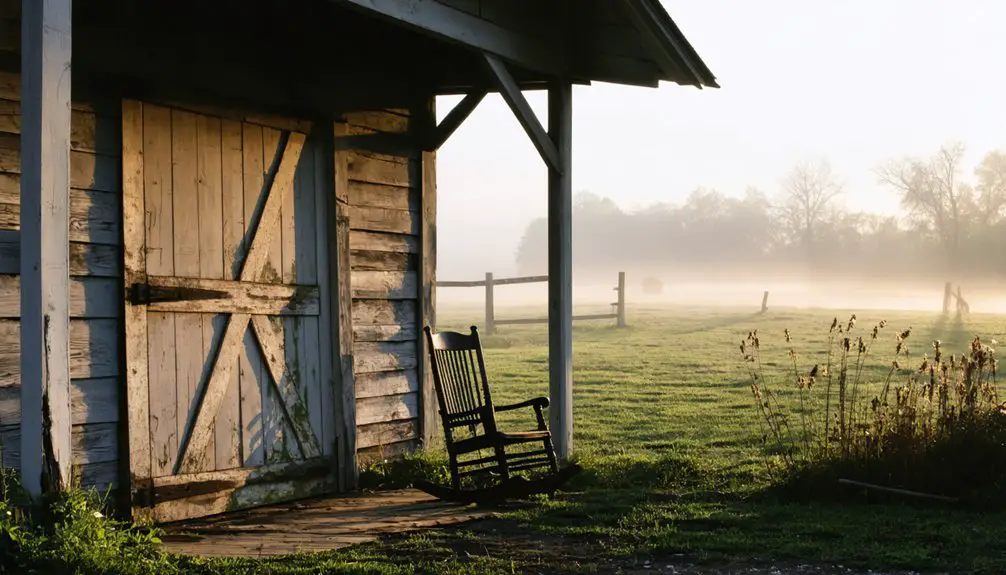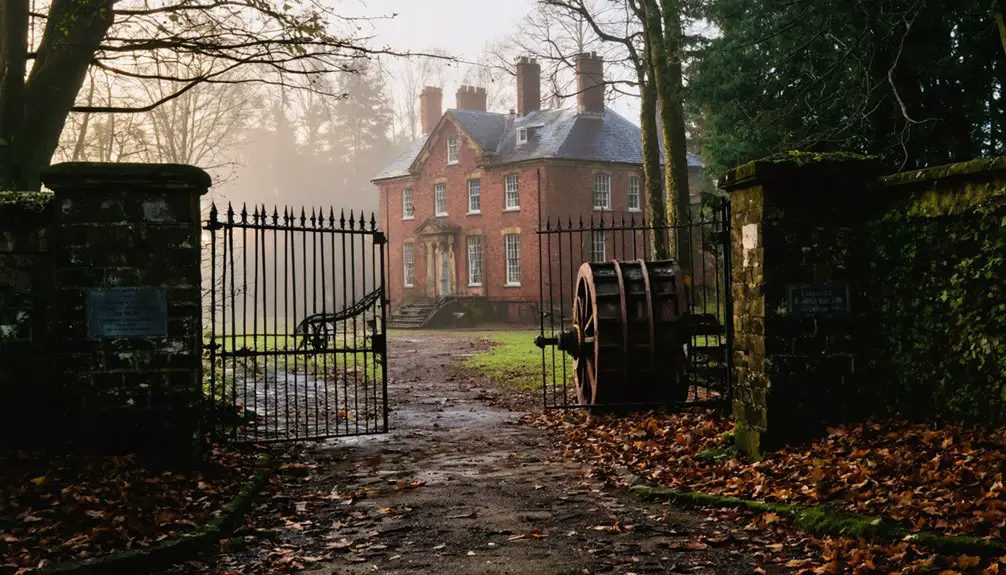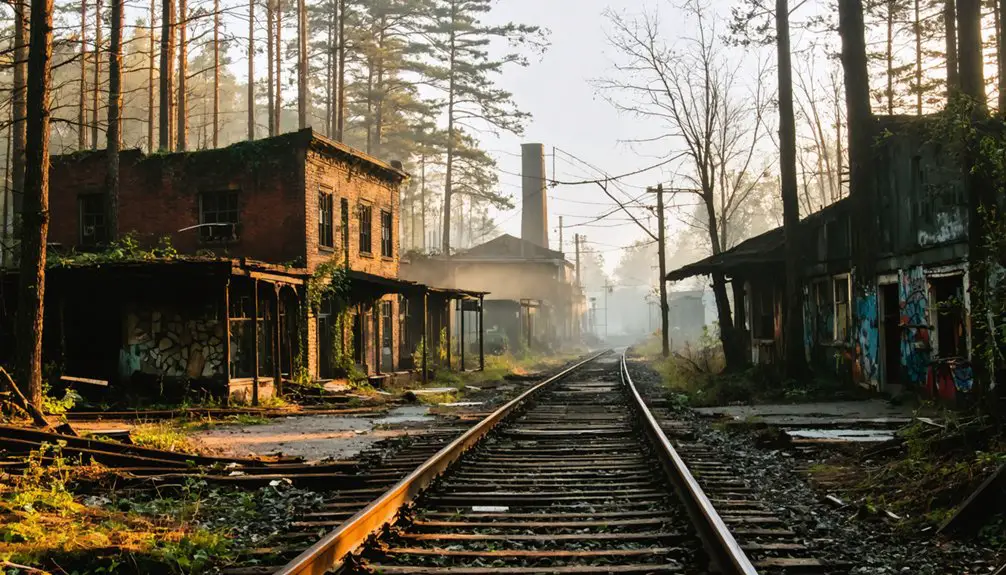You’ll discover Millbrook Village, an 1832 ghost town within New Jersey’s Delaware Water Gap National Recreation Area, where Abram Garris’s original gristmill sparked a thriving rural community. The village reached its peak in 1875 with 75 residents and 19 buildings, including a Methodist church and school. Today, you can explore preserved historic structures and watch costumed interpreters demonstrate 19th-century pioneer life during seasonal events like Millbrook Days. A deeper journey into this abandoned settlement reveals an untold story of early American resilience.
Key Takeaways
- Founded in 1832, Millbrook Village declined after railroad development redirected commerce, leading to the gristmill’s closure around 1900.
- The village reached its peak population of 75 residents in 1875 with 19 buildings before gradually becoming abandoned.
- Now preserved within Delaware Water Gap National Recreation Area, Millbrook functions as a living history museum demonstrating 19th-century rural life.
- Original structures including the Garis House, church, schoolhouse, and blacksmith shop have been restored using historic preservation techniques.
- The Millbrook Village Society maintains the ghost town’s legacy through educational programs and annual events like Millbrook Days Festival.
The Birth of a Mill Town (1832)
When local farmer Abram Garris constructed a gristmill along the newly completed Columbia-Walpack Turnpike in 1832, he laid the foundation for what would become Millbrook Village.
You’ll find the site where Garris chose to build wasn’t random – he strategically positioned his mill where the turnpike crossed Van Campen’s Mill Brook, ensuring reliable water power for gristmill operation.
With older mills in the region shuttered, including Van Campen’s original operation near the Depew Recreation Site, local farmers needed a new processing center.
Garris, who’d purchased 17 acres in the area, represented a wave of early settlers, many arriving from Pennsylvania.
The village’s name evolved naturally from Van Campen’s Mill Brook, eventually simplifying to Millbrook.
The village thrived as local farmers brought grain to be processed at the mill, driving the community’s early growth and development.
The settlement quickly became self-sufficient due to its remote location and limited access to outside resources.
Life Along the Columbia-Walpack Turnpike
The Columbia-Walpack Turnpike reshaped daily life in Millbrook Village and the surrounding region after its 1819 charter. You’d find farmers, merchants, and travelers maneuvering between the Blue Mountains and Flatbrook, where tollgates managed the flow of horse-drawn wagons along this essential corridor.
Horse-drawn wagons and bustling trade defined life along the Columbia-Walpack Turnpike, a vital artery through New Jersey’s rugged landscape.
As you walked through Millbrook Village in 1875, you’d see a thriving community of 75 residents spread along both sides of the turnpike. Local commerce flourished, with Abram Garris’s grist mill processing grain from nearby farms. Like many of New Jersey’s 19th century turnpikes, this road was constructed and operated by private companies.
Though rocks, ruts, and water made maintenance challenging, the turnpike remained significant for connecting rural settlements to markets.
Even today, you can spot remnants of this turnpike history in the stone walls and foundations that line Mountain Road, silent witnesses to an era of economic growth and community interconnection.
The Golden Era: A Self-Sufficient Community
Founded in 1832 around Abram Garris’s bustling gristmill, Millbrook Village emerged as a remarkably self-sufficient community between the Delaware River and Blue Mountains.
You’d have witnessed extraordinary community resilience as residents adapted to their isolation, growing their own food and developing essential trades. Local innovation flourished through blacksmiths, carpenters, and merchants who established businesses around the mill’s economic engine. Today, skilled docents demonstrate these historical trades and lifestyles for visitors. The Millbrook Village Society helps preserve history through Millbrook Days celebrations each year.
The village’s peak saw 75 residents occupying 19 buildings, including a Methodist church and school that served as cornerstones of daily life. At the heart of Millbrook’s economy, farmers brought their grain for processing, paying fees that sustained the village’s growth.
The community’s strength lay in its ability to provide nearly everything its residents needed through local production and trade.
Architecture and Notable Buildings
Standing as evidence to early American rural design, Millbrook’s architecture showcases locally sourced materials and practical 19th-century building techniques.
You’ll find hand-hewn beams, stone foundations, and wooden siding throughout the village’s historic preservation efforts, maintaining its authentic character.
At the heart of Millbrook’s architectural heritage stands the 1832 Grist Mill, built by Abram Garris along Van Campen’s Mill Brook.
The village’s church-school building, erected around 1840, features a distinctive dual-purpose design with a stone basement schoolroom and wooden-frame church above.
Along the Columbia-Walpack Turnpike, you’ll discover commercial structures like the blacksmith shop and general store, which combined workspace with living quarters. Today, visitors can experience live demonstrations of traditional crafts in these historic buildings.
These buildings, alongside modest residential homes, reflect the self-sufficient spirit of this rural 19th-century community.
While most structures are reproductions, several original buildings have survived and been preserved to maintain the village’s historical authenticity.
The Spangenberg Legacy
Pioneer settlers John Augustus Spangenberg and his descendants shaped Millbrook Village’s development throughout the 18th and 19th centuries.
You’ll find their heritage deeply woven into the village’s agricultural roots, starting with John’s early settlement in Sussex County during the 1700s. After arriving from Hamburg, Germany in 1753, John acquired his first tract of land in 1761.
James Spangenberg and his wife Sarah established the family’s prominence through successful farming operations, amassing property valued at $3,800 by 1860.
Their son Andrew inherited the family farm, while his children diversified the Spangenberg legacy.
George operated the village store and hotel around 1910, expanding the family’s influence beyond family agriculture.
The Spangenbergs’ marriages to other local families, like the Kithcarts and Garises, strengthened their social ties.
Even today, you can trace their impact through remaining structures and the village’s historical records.
In the 1950s, Len Spangenberg maintained a cabin near Millbrook, where cultural activities continued even as the village declined.
Economic Forces Behind the Decline
Several economic forces converged to trigger Millbrook Village’s decline in the late 19th century.
You’d have witnessed aging mills struggling to compete with modern facilities, while the railroad’s bypass left the village in economic isolation. Local farmers couldn’t keep pace with technological advances in agriculture, and Garis’ mill closure after 1900 eliminated a major employer. Much like Paterson’s experience with deindustrialization impacts, the loss of manufacturing jobs devastated the local workforce.
The village’s troubles deepened as young workers joined the labor migration to cities, shrinking the local customer base.
Transportation changes cut Millbrook off from essential trade networks, while the Great Depression dealt another blow to the rural economy.
By the 1960s, the Tocks Island Dam project sealed the village’s fate through property seizures, though the project never materialized.
These combined pressures transformed a once-thriving community into a ghost town.
From Bustling Village to Abandoned Settlement
The founding of Millbrook Village in 1832 marked the start of a vibrant rural settlement along Van Campen’s Mill Brook. You would’ve found a bustling community anchored by Abram Garris’s gristmill, with blacksmiths, merchants, and tradesmen serving local farmers.
By 1875, Millbrook’s population peaked at 75 residents across 19 major buildings, including a Methodist church and school.
But Millbrook’s history took a dramatic turn as economic changes reshaped the region. The arrival of railroads and the incorporation of Clinton town in 1865 diverted commerce away from this once-thriving village.
After the 1880s, you’d have witnessed the village’s steady decline, with the gristmill closing around 1900. By the mid-20th century, only the blacksmith shop remained operational, marking the end of Millbrook’s era as a self-sufficient community.
Preservation Efforts and Modern Recreation
You’ll find Millbrook Village‘s historic buildings meticulously restored through efforts of the Millbrook Village Society and Preservation Organization, established in 1972 as a nonprofit focused on protecting the site’s heritage.
The village now serves as a living history museum where you can experience traditional 19th-century crafts like blacksmithing and weaving, demonstrated by skilled interpreters in period-accurate settings.
Through ranger-led tours and educational programs, including the annual Millbrook Days festival, you’re able to explore authentically furnished historic structures while learning about rural colonial life in the Delaware Water Gap region.
Historic Building Restoration
Through extensive preservation efforts spanning decades, Millbrook Village’s historic buildings have undergone meticulous restoration to recreate an authentic 19th-century rural community.
The restoration team’s commitment to architectural authenticity is evident in their use of historic techniques and period-appropriate materials throughout the village.
You’ll find remarkable examples of preservation success in:
- The Garis House, restored to its 1860s appearance using physical evidence and historic photos
- Original structures like the church, schoolhouse, and blacksmith shop, maintained with strict attention to period detail
- The reconstructed grist mill, built on its original site using documented historic construction methods
The National Park Service and Millbrook Village Society continue their partnership to protect these treasures, ensuring you can experience genuine 19th-century Upper Delaware Valley architecture firsthand.
Community Education Programs
Since its establishment in 1972, Millbrook Village Society has spearheaded extensive educational programs that seamlessly blend preservation with recreation.
You’ll find docent-led demonstrations showcasing pioneer life, where you can experience authentic 1800s crafts and daily activities firsthand. Through community workshops and seasonal events like “Millbrook Days,” you’ll immerse yourself in the village’s historical narrative while connecting with fellow history enthusiasts.
The society’s partnership with Delaware Water Gap National Recreation Area expands opportunities for hands-on learning.
You’re welcome to participate in pioneer life reenactments, traditional farming demonstrations, and blacksmithing workshops. Youth programs integrate service learning with preservation efforts, while nature trails and picnic areas provide spaces for outdoor exploration.
Through these programs, you’ll actively contribute to preserving Millbrook’s heritage while enjoying recreational activities.
Seasonal Events and Living History
You’ll find the village comes alive during the Annual Millbrook Days Festival in mid-September, where costumed interpreters demonstrate 19th-century pioneer crafts and trades.
Throughout the year, you can watch seasonal demonstrations of traditional skills like maple sugaring in early spring and blacksmithing in the restored workshop.
The Millbrook Village Society organizes these living history events and heritage gatherings, helping visitors connect with authentic aspects of 1800s rural life through hands-on exhibits and period-accurate presentations.
Mill Days Festival Highlights
Every September, visitors can step back in time during the annual Millbrook Days festival, where over 150 costumed volunteers transform the village into a vibrant 19th-century rural community.
You’ll find an immersive experience showcasing traditional crafts and historical demonstrations throughout the village’s authentic buildings from 10 a.m. to 4 p.m.
The festival activities highlight three main attractions:
- Hands-on participation in traditional skills like blacksmithing, woodworking, rope making, and open-hearth cooking
- Children’s period games including marbles, ring toss, sack races, and corn husk doll making
- Traditional folk music performances while craftspeople demonstrate spinning, weaving, and quilting
You’re free to explore at your own pace, with convenient shuttle service from remote parking lots making the village easily accessible.
Pioneer Crafts and Demonstrations
Throughout summer weekends from Memorial Day to Labor Day, Millbrook Village comes alive with authentic pioneer craft demonstrations and living history exhibits.
You’ll see skilled volunteers in period costumes showcasing traditional pioneer skills from 10 AM to 4 PM, including weaving on 19th-century looms, blacksmithing, and wool spinning.
During Millbrook Days in early September, over 150 volunteers demonstrate rural craft techniques rain or shine.
You’ll witness candle making, basket weaving, and agricultural practices that were essential to 19th-century life.
The Millbrook Village Society’s trained docents provide historical context while showing you step-by-step production methods.
These demonstrations preserve traditional craftsmanship and offer you a genuine glimpse into America’s pioneer heritage, all free to the public at this Delaware Water Gap site.
Holiday Heritage Gatherings
During the holiday season, Millbrook Village transforms into a festive celebration of colonial heritage with traditional events that capture the spirit of 19th-century rural life.
Experience these holiday traditions firsthand as you explore the Amy B. Yerkes Museum’s seasonal exhibits and join costumed interpreters for authentic reenactments.
You’ll discover festive gatherings that highlight the region’s rich history through:
- Colonial-themed Christmas tree lighting with period caroling and refreshments
- Santa’s arrival in vintage sleighs reminiscent of historic fire engines
- Free admission to Millbrook Days fall festival featuring apple cider pressing and folk music
Don’t miss the chance to dress in period attire (“bib and tucker”) while exploring historic buildings and participating in traditional customs that bring the village’s past to life through interactive demonstrations and community celebrations.
Natural Beauty and Geographic Significance
Nestled within the Delaware Water Gap National Recreation Area, Millbrook Village occupies a scenic location in Hardwick Township, Warren County, New Jersey at coordinates 41.07333°N, 74.96306°W.
You’ll find this historic ghost town along Old Mine Road, where Van Campen’s Mill Brook flows as an essential Delaware River tributary.
The village’s natural conservation efforts protect diverse ecosystems, including hardwood forests of oak, maple, and hickory that support wildlife like white-tailed deer and black bears.
You can explore hiking trails that showcase the area’s ecological tourism potential, offering spectacular views of river vistas and seasonal displays of wildflowers and autumn foliage.
The surrounding landscape, at 656 feet elevation, features woodland, hills, and river valleys that exemplify the region’s untamed beauty within this federally protected recreation area.
Frequently Asked Questions
Were There Any Documented Crimes or Notable Incidents in Millbrook Village?
You won’t find any documented crime statistics or notable incidents in this location – historical records show no violence or criminal activity during its active years as a peaceful farming community.
What Happened to the Original Residents’ Belongings After They Abandoned Millbrook?
Like pieces of a puzzle, the abandoned artifacts scattered when families left, taking cherished belongings with them. You won’t find many residents’ memories there – most items disappeared or were collected by preservationists.
Did Any Native American Settlements Exist in the Area Before Millbrook?
You’ll find strong evidence of Native American presence along Old Mine Road’s corridor, though there’s no documented tribal history of settlements directly at Millbrook’s location before its 1832 founding.
What Was the Average Property Value of Homes During Millbrook’s Peak?
You’d be amazed how the property market fluctuated, but based on historical appraisal patterns of similar rural NJ villages, homes likely averaged between $500-$1,500 during the 1850s-1860s peak period.
Were There Any Epidemic Outbreaks or Health Crises in Millbrook’s History?
You won’t find direct evidence of epidemic outbreaks in Millbrook’s health crisis history. While nearby towns battled typhoid and tuberculosis, the village’s small size and isolation likely protected its residents.
References
- https://www.youtube.com/watch?v=aYfPWs3G34M
- https://www.legendsofamerica.com/millbrook-village-new-jersey/
- https://bestofnj.com/features/travel/jersey-through-history-millbrook-village/
- https://www.nps.gov/thingstodo/millbrook-village-dewa.htm
- https://njskylands.com/history-millbrook-village
- https://npshistory.com/publications/dewa/brochures/millbrook-village-2009.pdf
- https://npshistory.com/publications/dewa/hrs-millbrook-village.pdf
- https://npplan.com/parks-by-state/pennsylvania-national-parks/delaware-water-gap-national-recreation-area-park-at-a-glance/delaware-water-gap-national-recreation-area-historic-sites/delaware-water-gap-national-recreation-area-millbrook-village/
- https://walpackhistory.org/newsletters/Walpack-Newsletter-Summer-2019.pdf
- https://en.wikipedia.org/wiki/List_of_turnpikes_in_New_Jersey



